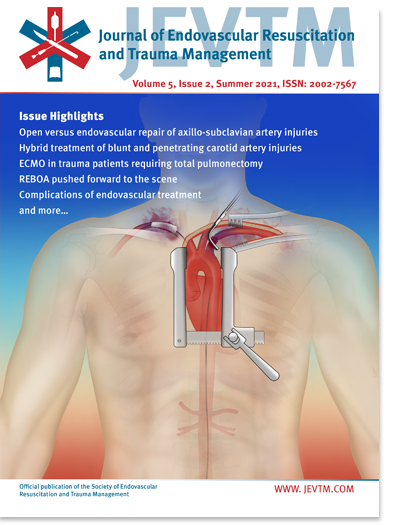Contemporary Management of Axillo-subclavian Arterial Injuries Using Data from the AAST PROOVIT Registry
DOI:
https://doi.org/10.26676/jevtm.v5i2.201Keywords:
Axillo-subclavian Injury, Endovascular Repair, Vascular, TraumaAbstract
Background: Endovascular repair has emerged as a viable repair option for axillo-subclavian arterial injuries in select patients; however, further study of contemporary outcomes is warranted.
Methods: The American Association for the Surgery of Trauma (AAST) PROspective Observational Vascular Injury Treatment (PROOVIT) registry was used to identify patients with axillo-subclavian arterial injuries from 2013 to 2019. Demographics and outcomes were compared between patients undergoing endovascular repair versus open repair.
Results: 167 patients were identified, with intervention required in 107 (64.1%). Among these, 24 patients underwent open damage control surgery (primary amputation = 3, ligation = 17, temporary vascular shunt = 4). The remaining 83 patients (91.6% male; mean age 26.0 ± 16) underwent either endovascular repair (36, 43.4%) or open repair (47, 56.6%). Patients managed with definitive endovascular or open repair had similar demographics and presentation, with the only exception being that endovascular repair was more commonly employed for traumatic pseudoaneurysms (p = 0.004). Endovascular repair was associated with lower 24-hour transfusion requirements (p = 0.012), but otherwise the two groups were similar with regards to in-hospital outcomes.
Conclusion: Endovascular repair is now employed in > 40% of axillo-subclavian arterial injuries undergoing repair at initial operation and is associated with lower 24-hour transfusion requirements, but otherwise outcomes are comparable to open repair.
Published
How to Cite
Issue
Section
License
Copyright (c) 2021 Journal of Endovascular Resuscitation and Trauma Management

This work is licensed under a Creative Commons Attribution 4.0 International License.
Authors of content published in the JEVTM retain the copyright to their works.
Articles in the JEVTM are published under the terms of a Creative Commons CC BY 4.0 license, which permits use, downloading, distribution, linking to and reproduction in any medium, provided the original work is properly cited.




